Whelping and Raising Puppies
Week 8
The countdown is on...
Puppies will be beginning to leave for their new homes between 9 and 12 weeks of age. By 8.5 to 9 weeks puppies are usually ready to leave their littermates and are ready for individual attention. Many breeders choose to keep some breeds longer to temperament test them, as dominant and subordinate behaviors start to develop, and depending on the breed, this is an important factor when placing puppies. Some pets are kept longer for show potential assessing. Some are kept longer until they are older for shipping. Some are kept until they can be altered or so genetic testing can be done. There are many good reasons a breeder will keep puppies past eight weeks, and no good reasons to send a pup off earlier than this age. Pups are also ready to begin housetraining at eight weeks. Make sure your breeder knows a little about your lifestyle, family and dog experience, as she will need to know some things about your family to properly place the correctly tempered puppy with you.
Ideally the puppy you are purchasing will be potty trained to a potty station from 3 to 9 weeks and should be understanding that there is a designated spot to relieve itself. With these well-raised puppies the owner continues the training to the next step teaching the pup how to walk to the door to alert you it needs to go to the bathroom.
Pups that have no potty training at the breeders home, and are raised in a rack, or a paper lined pen such as the ones they use at pet stores, eat, sleep, play and go to the bathroom all in the same area, and are harder to house train. They have no concept of looking for a designated spot. They just pee in their living quarters. When racks are used the waste simply disappears.
Remember, NO puppy is house trained at 9 weeks, that is the new owners job to teach them to walk to a door, but having the early training to teach them there is a designated spot to relieve itself makes house training much faster and easier.
Hopefully your pup will come crate trained and the breeder will have worked on that from 7 to 9 weeks. By 8 weeks, the pups should be able to go solo in a crate for 2 hour naps. I personally prefer not to send a pup to its new home until the pup is comfortable being in a crate alone. Not all breeders take the time to introduce a crate. A pup that is comfortable alone in a crate will adjust better to its new home and is less likely to experience separation anxiety. When this extra time was spent it is a real bonus for both puppy and owner.
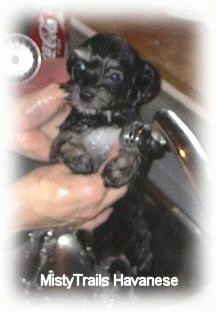
They get a nice bath before they go. As a breeder we have done 3 to 5 baths prior to leaving, just to get them used to it.
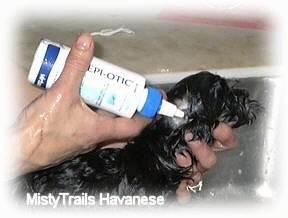
They do not really need an ear cleaning but I do this after every bath as the product is also a drying agent that will dry up any water you may have gotten in their ears. All dogs love a good ear massage and cleaning.

Emily and the puppy both love cuddles...
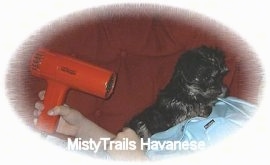
…and blow-dry. Pups get used to all sorts of new things from 7 to 9 weeks at the breeders home.
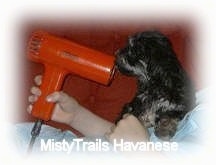
Including a vaccuum. This is why house raised pups excel over barn raised or basement raised pups.

Their nails are done one last time. Be careful not to cut the quick, or your puppy will not be so trusting to let you do it routinely.
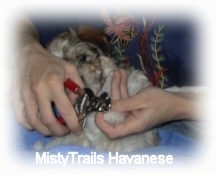
Frequent trimming will make the quick retract and enable you to keep your dog’s nails short. It is nice to cut them as short as possible, as this makes the quick retract. Also have QUIK STOP on hand in case you go too short.
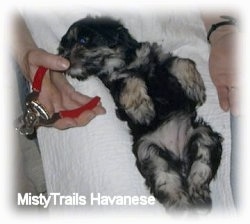
Your puppy should be totally relaxed on his/her back in a submissive position. This puppy is totally trusting and relaxed, which makes nail trimming easy.
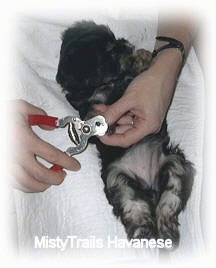
If your young puppy will not stay willingly in this position make him/her do so. You must be the dominant one, and win its trust and respect.

Some new puppies that haven't had proper socialization from the original breeder, or those puppies with pushy attitudes that do not want to lie on their backs, may need some work to get them used to this position. A good technique is to put them on their backs daily. Start with foot massages then go to individual toe massages. Progress to pretend nail trimming daily and then on to the real thing. I have heard from some new owners that it takes two of them to hold the puppy down to trim nails and some even need to give a tranquilizer before grooming. It would be nice to attempt to make the puppy enjoy the grooming rather than having it be a constant unpleasant experience for both dog and owner.

Have more than one person practice laying each puppy on its back, and teach the pup to be trusting of people to willingly lie on his/her back. This will make future vet examinations and grooming much easier on both dog and owner. Pictured is Emma laying happily and willingly on her back for Stan.
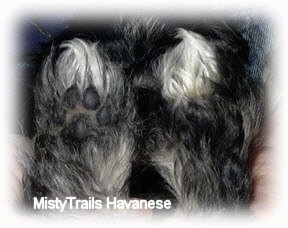
Left - Bottom of the puppy's foot groomed so the pads of the foot show. Right - Hair covering the bottom of the puppy's foot.
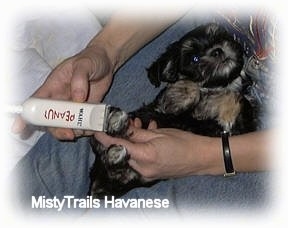
With this breed (Havanese), their hair grows and causes "slipper feet" so I trim the hair from the bottom pads of their feet. This will be something the new owner will need to continue, along with routine combing, ear cleaning, ear hair plucking and nail trimming. Some owners will choose to grow hair long, and some will prefer a shorter ”puppy cut.” Some will take their pups to a professional groomer, others enjoy the grooming themselves.
Your puppy’s socialization started with the breeder, but now it is the new owner’s responsibility to continue the process. The socialization that your puppy receives up to 12 weeks of age is the most important, as that is the time when he/she forms his/her impressions of the outside world. Eight to ten weeks is classified as a fear period, but I have seen puppies totally skip this fear period. For those puppies that are a little unsure of themselves, at this age interaction should be gentle and reassuring. Do not overwhelm puppies between eight and ten weeks of age. That is the age to explore their new home. They are not ready for the big world yet and besides, they haven't had enough booster shots to be taken out everywhere. LACK of socialization after ten weeks can display itself in fear and aggression as the dog grows up. Improper socialization with rough unsupervised children can also form negative behavior. Make sure all child-puppy play is supervised. Not only could the child hurt the puppy, but an over-exuberant puppy could accidentally nip a child.
INCLUDE lots of human contact of all ages, affection, handling in all different positions (including the down on back position frequently), grooming and exposure to other animals. Put your head down near the dish as if you are going to share dinner, get all family members to do this. The dog should NEVER growl to protect his dinner; nip this quick if the puppy starts growling. A dog is a pack animal and needs to have a leader. If he doesn't, then he will become the leader. For more info on dog behavior read Understanding Dog Behavior.
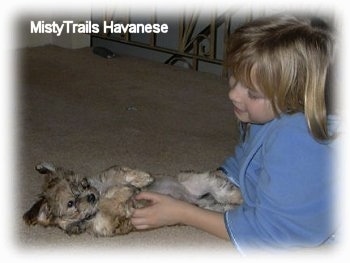
Lots of play on their backs... Emma at 10 weeks... Puppies can be so cute that it can be hard to establish dominance, however you have to. You will NOT break their spirit, you will earn it. Puppies have to also learn that it is okay to spend time alone. Emma doesn't whine anymore when alone, she has learned that being alone is okay. She doesn't like to be alone, but is not afraid or anxious when she is left alone.
Courtesy of MistyTrails Havanese
Main Menu













